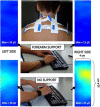Surface EMG in Clinical Assessment and Neurorehabilitation: Barriers Limiting Its Use
- PMID: 32982942
- PMCID: PMC7492208
- DOI: 10.3389/fneur.2020.00934
Surface EMG in Clinical Assessment and Neurorehabilitation: Barriers Limiting Its Use
Abstract
This article addresses the potential clinical value of techniques based on surface electromyography (sEMG) in rehabilitation medicine with specific focus on neurorehabilitation. Applications in exercise and sport pathophysiology, in movement analysis, in ergonomics and occupational medicine, and in a number of related fields are also considered. The contrast between the extensive scientific literature in these fields and the limited clinical applications is discussed. The "barriers" between research findings and their application are very broad, and are longstanding, cultural, educational, and technical. Cultural barriers relate to the general acceptance and use of the concept of objective measurement in a clinical setting and its role in promoting Evidence Based Medicine. Wide differences between countries exist in appropriate training in the use of such quantitative measurements in general, and in electrical measurements in particular. These differences are manifest in training programs, in degrees granted, and in academic/research career opportunities. Educational barriers are related to the background in mathematics and physics for rehabilitation clinicians, leading to insufficient basic concepts of signal interpretation, as well as to the lack of a common language with rehabilitation engineers. Technical barriers are being overcome progressively, but progress is still impacted by the lack of user-friendly equipment, insufficient market demand, gadget-like devices, relatively high equipment price and a pervasive lack of interest by manufacturers. Despite the recommendations provided by the 20-year old EU project on "Surface EMG for Non-Invasive Assessment of Muscles (SENIAM)," real international standards are still missing and there is minimal international pressure for developing and applying such standards. The need for change in training and teaching is increasingly felt in the academic world, but is much less perceived in the health delivery system and clinical environments. The rapid technological progress in the fields of sensor and measurement technology (including sEMG), assistive devices, and robotic rehabilitation, has not been driven by clinical demands. Our assertion is that the most important and urgent interventions concern enhanced education, more effective technology transfer, and increased academic opportunities for physiotherapists, occupational therapists, and kinesiologists.
Keywords: clinical applications; education; motion analysis; movement sciences; physiotherapy; rehabilitation; sEMG; surface electromyography.
Copyright © 2020 Campanini, Disselhorst-Klug, Rymer and Merletti.
Figures








Similar articles
-
Analysis and Biophysics of Surface EMG for Physiotherapists and Kinesiologists: Toward a Common Language With Rehabilitation Engineers.Front Neurol. 2020 Oct 15;11:576729. doi: 10.3389/fneur.2020.576729. eCollection 2020. Front Neurol. 2020. PMID: 33178118 Free PMC article.
-
Use of Surface EMG in Clinical Rehabilitation of Individuals With SCI: Barriers and Future Considerations.Front Neurol. 2020 Dec 18;11:578559. doi: 10.3389/fneur.2020.578559. eCollection 2020. Front Neurol. 2020. PMID: 33408680 Free PMC article.
-
Fundamental Concepts of Bipolar and High-Density Surface EMG Understanding and Teaching for Clinical, Occupational, and Sport Applications: Origin, Detection, and Main Errors.Sensors (Basel). 2022 May 30;22(11):4150. doi: 10.3390/s22114150. Sensors (Basel). 2022. PMID: 35684769 Free PMC article. Review.
-
Translation of surface electromyography to clinical and motor rehabilitation applications: The need for new clinical figures.Transl Neurosci. 2023 Mar 14;14(1):20220279. doi: 10.1515/tnsci-2022-0279. eCollection 2023 Jan 1. Transl Neurosci. 2023. PMID: 36941919 Free PMC article.
-
Metrology in sEMG and movement analysis: the need for training new figures in clinical rehabilitation.Front Rehabil Sci. 2024 Jan 29;5:1353374. doi: 10.3389/fresc.2024.1353374. eCollection 2024. Front Rehabil Sci. 2024. PMID: 38348456 Free PMC article. Review.
Cited by
-
Transferring Sensor-Based Assessments to Clinical Practice: The Case of Muscle Synergies.Sensors (Basel). 2024 Jun 18;24(12):3934. doi: 10.3390/s24123934. Sensors (Basel). 2024. PMID: 38931719 Free PMC article.
-
Monitoring Involuntary Muscle Activity in Acute Patients with Upper Motor Neuron Lesion by Wearable Sensors: A Feasibility Study.Sensors (Basel). 2021 Apr 30;21(9):3120. doi: 10.3390/s21093120. Sensors (Basel). 2021. PMID: 33946234 Free PMC article.
-
Effects of Force Modulation on Large Muscles during Human Cycling.Brain Sci. 2021 Nov 19;11(11):1537. doi: 10.3390/brainsci11111537. Brain Sci. 2021. PMID: 34827536 Free PMC article.
-
Outcome measures for assessing the effectiveness of physiotherapy interventions on equinus foot deformity in post-stroke patients with triceps surae spasticity: A scoping review.PLoS One. 2023 Oct 12;18(10):e0287220. doi: 10.1371/journal.pone.0287220. eCollection 2023. PLoS One. 2023. PMID: 37824499 Free PMC article.
-
Machine Learning- and Deep Learning-Based Myoelectric Control System for Upper Limb Rehabilitation Utilizing EEG and EMG Signals: A Systematic Review.Bioengineering (Basel). 2025 Feb 3;12(2):144. doi: 10.3390/bioengineering12020144. Bioengineering (Basel). 2025. PMID: 40001664 Free PMC article. Review.
References
-
- Pons J, Torricelli D, Pajaro M. editors. Converging Clinical and Engineering Research on Neurorehabilitation. Berlin; Heidelberg: Springer Berlin Heidelberg; (2013).
-
- Pons J, Torricelli D. editors. Emerging Therapies in Neurorehabilitation. Berlin; Heidelberg: Springer Berlin Heidelberg; (2014).
LinkOut - more resources
Full Text Sources
Medical

